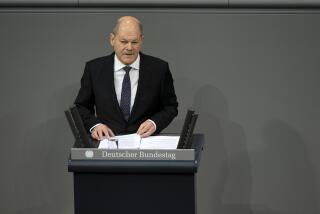Germany Has Rest of Europe Toeing the Mark : Interest rates: The Bundesbank is maintaining rates at high levels to finance reunification. Other nations are forced to scramble to keep up and are paying the price.
- Share via
BRUSSELS — Interest rates and currency values in Europe are bouncing up and down like yo-yos, in part because of pressure from the chronically weak dollar. And where the markets settle will help determine economic growth rates and inflation rates not only throughout Europe but, at least to some extent, in the United States as well.
To most analysts, the immediate villain in Europe’s volatility is Germany. The Bundesbank, Germany’s central bank, is maintaining short-term interest rates at high levels in its never-ending war against inflation, which has been fueled by the enormous cost of reunification with the former East Germany.
German short-term rates, now almost 10%, are attracting investment money from all over the world; that, in turn, is boosting the German mark’s value against other European currencies, as well as against the dollar.
Other countries, particularly in Europe, are finding it necessary to boost their own interest rates to prevent devaluation of their own currencies. High rates are depressing economic growth at a time when many European economies were already sputtering.
“All of Europe is paying the price for German unity,” said Olle Djerf, head of economic research for Stockholm’s Nordbanken.
Germany could relax its grip on interest rates if it would raise taxes, cut government subsidies and otherwise reduce its mounting budget deficit, said Jim O’Neill, the chief currency analyst at Swiss Bank Corp. in London. Instead, like the United States in the early 1980s, Germany is relying entirely on tight money to restrain inflation.
The United States is no mere innocent bystander. Its policy of benign neglect toward the dollar has intensified the squeeze on most European currencies.
Almost alone among industrial countries, the United States has not tried to compete with Germany on interest rates. The Federal Reserve has formally cut interest rates six times in the last year and a half in an effort to stimulate the U.S. economy. Consequently, short-term Treasury bills yield only about 3%, and investors are turning increasingly to Germany for better returns.
The downward pressure that Germany is exerting on other currencies is not entirely unwelcome. A weaker pound, for example, makes British goods less costly in world markets. (The same is true for the dollar, and the United States has been willing to let the dollar sink to record low levels this summer against the mark as a way of boosting American exports.)
But for most countries, there is a great price to pay. That price is inflation.
Just as a weak currency lowers the price of a nation’s exports on world markets, so does it lift the price of goods that country buys from abroad. This effect is much more pronounced in Europe because European countries depend more heavily on international trade than does the larger, more self-sufficient United States.
It is Swiss Bank’s O’Neill’s rule of thumb that a European country whose currency loses 10% of its value this year can expect an additional 1 percentage point of inflation next year.
But in today’s Europe, maintaining a currency’s value means competing with Germany on interest rates. This week, it was Finland that was the first European nation to crack under the pressure. The Finnish markka fell a breathtaking 13% on Tuesday after Finland abandoned its effort to link the currency’s value to that of the rest of Europe. “It was far too painful” for Finland, whose economic output had declined by 6.5% in 1991, to maintain interest rates high enough to protect its currency, said Darren Cullen, an economist with the Salomon Bros. International investment house in London.
Sweden, under similar pressure, didn’t blink. Instead, it pushed up the overnight rate at which banks borrow from the government, first from 16% to 24% and then to an astonishing 75%.
Djerf, the Nordbanken economist, interpreted the 75% rate as a signal of the government’s determination to stick to its new anti-inflation policy. He said it would take a toll on Sweden’s economic output, which fell 1.5% last year and is expected to decline another 1% this year.
“You can’t live more than a matter of days with such a rate,” said Djerf. He predicted that the Riksbank, Sweden’s central bank, will bring the rate back down on Monday, perhaps to 24%.
Sweden also wants to prove to the European Community that it is serious about maintaining the value of its currency, Djerf said. Sweden has applied for membership in the 12-nation EC, and one requirement for entry is a stable currency. Indeed, the EC commission criticized Finland, also an EC applicant, for devaluing its currency.
Some of the EC members’ own currencies are under intense pressure from the German mark. Eleven of the 12 EC countries (all but Greece) have entered an arrangement for keeping their currency values closely in line with each other.
O’Neill predicted that Italy and Britain, despite their best efforts, will soon have to accept a formal devaluation of their currencies against the mark.
The Italian lira slipped under its floor against the mark several times this week. To prop up its currency, Italy raised interest rates and used its foreign reserves to buy lira, but O’Neill said Italy is running out of the foreign currency it needs to maintain this strategy.
The currency markets are looking for direction from the French vote on Sept. 20 on the EC treaty that would create a common currency in 1999--and require EC nations to bring down their budget deficits and inflation rates in order to join the currency union.
More to Read
Sign up for Essential California
The most important California stories and recommendations in your inbox every morning.
You may occasionally receive promotional content from the Los Angeles Times.










